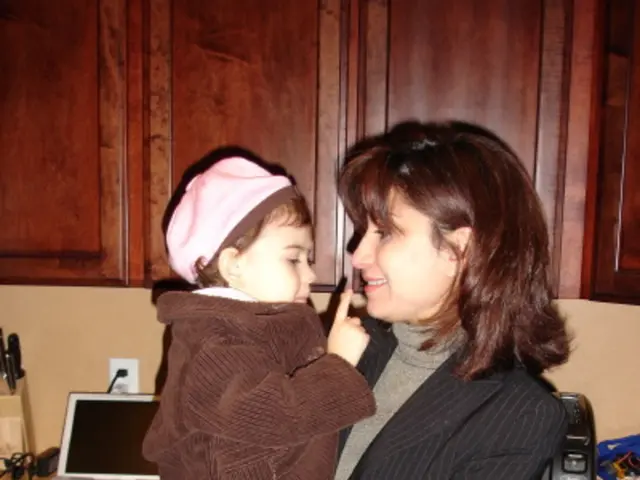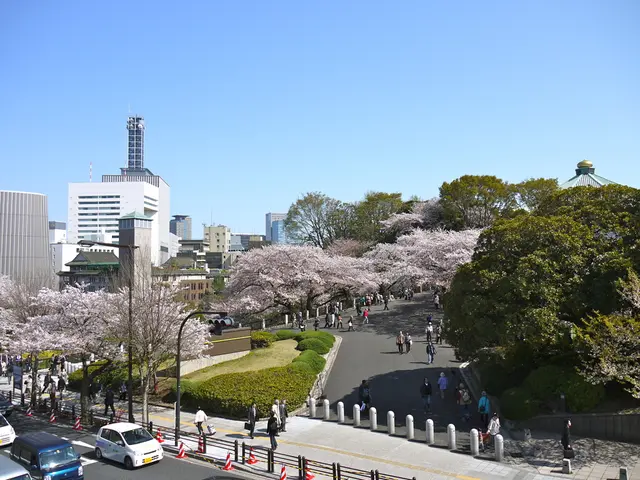Perception and Construction of Colors: Brain's Role in Interpreting and Crafting Artistic Hues
Cracking the code on colors: why do some hues make us feel relaxed while others get our blood pumping? It's all thanks to the complex ways our noggin processes and interprets these visual cues. 'Cause color, mate, it's more than just a sensory experience. It's got a deep-rooted impact on our emotions and artistic creations!
Let's dive into the nitty-gritty of how our brains work their magic with colors:
The Neurological Nitty-Gritty
Er, where does it all start? With light, mate. Visible light consists of various wavelengths - each one corresponds to a different color. When light beams smack an object, it absorbs some wavelengths and reflects others. For example, a ripe tomato? It sucks up most wavelengths, but it reflects red - that's why we see it as red, alright?
But eyes, they ain't the only ones doin' the work here. You've got these photoreceptor cells called rods and cones in your retina, and they're the real heroes. While rods are for low light vision, cones are the stars in the color show. And humans, we've typically got three kinds of cones, each sensitive to different wavelength ranges: red, green, and blue.
The Neural Mixture
So, what happens next? The brain takes the info from these cones and jumbles it up to create the full spectrum of colors. This process, mate, is known as trichromatic color vision. The brain figures out varying levels of stimulation from each type of cone and interprets them as different colors. For instance, if both red and green cones are stimulated, the brain might see that as yellow. This neural jumbling is why we get to enjoy a rainbow of colors, from the vibrant shades in a painting to the subtle hues in a sunset.
The Psychological Effects
Colors aren't just visual elements, they've also got psychological impacts that can sneakily influence our emotions and vibes. Ever wondered why designers and artists carefully choose colors? Yep, that's to evoke specific feelings!
Here's a quick lowdown on some common color associations:
- Red: Oh boy, this one's often associated with passion, energy, and excitement. Can also signal danger or urgency.
- Blue: Chill, calm, and collected - blue's usually linked to those traits. It's known to slow down the body's metabolism and creates a soothing effect.
- Yellow: Cheer up, buttercup! Yellow represents happiness, creativity, and warmth - it's a color that can lift our spirits, mate.
- Green: Ah, nature and growth - green symbolizes that. It's easy on your eyes and encourages a sense of peace.
- Purple: Wealth, mystery, and spirituality - purple's often used to convey depth and introspection.
Which makes sense 'cause understanding these connections helps artists use color intentionally to communicate emotions and themes in their work. It also explains why art can have such a profound effect on us.
Art with Color
Artists be using color in much the same way a writer uses words, mate. They pick their colors to convey messages and moods, much the same as a writer chooses their words. The choice of color palette can define the feel of a piece of art, influence our emotional response, and guide the story that's told through the art.
The Science in the Art
Art, it ain't just passively interpreted by the brain. Nah, the brain's involved in creating the art too! It's your brain that decides how to apply those color theories and emotions onto the canvas. The creative process involves several brain areas, including those responsible for planning, decision-making, and emotional response.
Studies in neuroscience suggest that the brain's right hemisphere plays a significant role in creative tasks, including art and color processing. This hemisphere's good at tracing patterns, interpreting visual imagery, and understanding spatial relationships, all crucial when working with colors and creating art.
Moreover, creating art can boost our mental health and enhance problem-solving skills, making us feel all chipper! Sweet!
Individual Differences
It's not like everyone perceives colors the same way, ya know. There's color blindness - when folks have a harder time distinguishing certain colors or see them differently. This usually has something to do with differences in the cones in their retinas. There are also conditions, like synesthesia, where people see colors when they hear music or read words. This cross-wiring of the senses can create a unique, vibrant artistic expression.
Enhancing Cognitive Function
The complex process of color perception and art creation? It's not just entertaining but also beneficial for our cognitive health, mate. As we grow older, keeping the old grey matter sharp becomes more important than ever. Enter brain supplements, often called nootropics - these dudes are designed to enhance cognitive functions such as memory, creativity, and even mood.
Ingredients like omega-3 fatty acids, found in fish oil, are known for their brain-boosting properties and support overall brain health. Ginkgo biloba, an ancient plant extract, may improve blood circulation to the brain, potentially enhancing mental clarity and focus.
L-theanine, an amino acid found in tea leaves, is celebrated for its calming effects without causing drowsiness - a plus if you're an artist looking to chill and focus on your craft. And caffeine? It's frequently found in these supplements, and it's known to boost alertness and attention.
By adding brain supplements to your routine, you might discover enhanced cognitive functions that make your interactions with colors and art even more fascinating!
The Rainbow Spectrum
The science behind color perception provides a glimpse into how intricately our brains are wired to interpret and create art. From the retina's cones capturing light waves to the brain's interpretation and emotional response, our perception of color is a complex, multi-faceted process. This understanding enhances our appreciation for art and underscores the powerful influence colors have on our emotions and mental states. So, next time you're gazing at a vibrant sunset or a thought-provoking painting, remember: your brain's working overtime to create that moment of awe!
- Our brains process colors through complex neurological mechanisms, starting with visible light consisting of various wavelengths.
- When light encounters an object, it absorbs some wavelengths and reflects others, which we perceive as different colors.
- The eyes absorb light with the help of photoreceptor cells called rods and cones in the retina.
- Humans have three types of cones, each sensitive to different wavelength ranges: red, green, and blue.
- The information from the cones is jumbled up in the brain to create the full spectrum of colors, a process known as trichromatic color vision.
- Different levels of stimulation from each type of cone are interpreted as different colors by the brain.
- Color associations can have deep psychological impacts and influence our emotions and artistic creations.
- Red is often associated with passion, energy, and excitement, but can also signal danger or urgency.
- Blue is known for its calming effects and stimulating feelings of peace and tranquility.
- Yellow represents happiness, creativity, and warmth, and is capable of lifting our spirits.
- Green symbolizes nature and growth, and is easy on the eyes, promoting a sense of peace.
- Purple is linked to depth, introspection, spirituality, and luxury.
- Artists choose their color palettes to evoke specific emotions and themes in their work, much like a writer chooses their words.
- The creative process involves several brain areas, including those responsible for planning, decision-making, and emotional response.
- Studies in neuroscience suggest that the brain's right hemisphere plays a significant role in creative tasks.
- Creating art can have therapeutic benefits for our mental health and enhance problem-solving skills.
- Individual differences in color perception exist, such as color blindness and synesthesia, which can affect artistic expression.
- Enhanced cognitive functions through nootropic supplements can make interactions with colors and art more engaging and meaningful.
- Omega-3 fatty acids are brain-boosting ingredients found in fish oil that support overall brain health.
- Ginkgo biloba may improve blood circulation to the brain, potentially enhancing mental clarity and focus.
- L-theanine, an amino acid found in tea leaves, is celebrated for its calming effects without causing drowsiness.
- Caffeine is frequently found in brain supplements and boosts alertness and attention.
- Brain supplements can enhance cognitive functions such as memory, creativity, and mood.
- Art requires a balance of focus and creativity, two cognitive functions that can be boosted through nootropics.
- Mental health is closely related to brain health, and maintaining good brain health is important in old age.
- Chronic diseases and medical conditions can impact brain health and mental well-being, emphasizing the need for proactive self-care.
- Environmental science plays a role in brain health, as factors like climate change and air pollution can affect neurological processes.
- Products like CBD, a compound found in cannabis, are sometimes used for their potential mental health benefits.
- Neurological disorders and mental health conditions such as Alzheimer's disease and depression require ongoing therapies and treatments.
- Diet, exercise, skin care, and lifestyle choices play a role in maintaining good mental and physical health.
- Career development, personal growth, and education are important aspects of workplace wellness, which encompasses various aspects of health and well-being, including mental health, physical fitness, and overall well-being.








